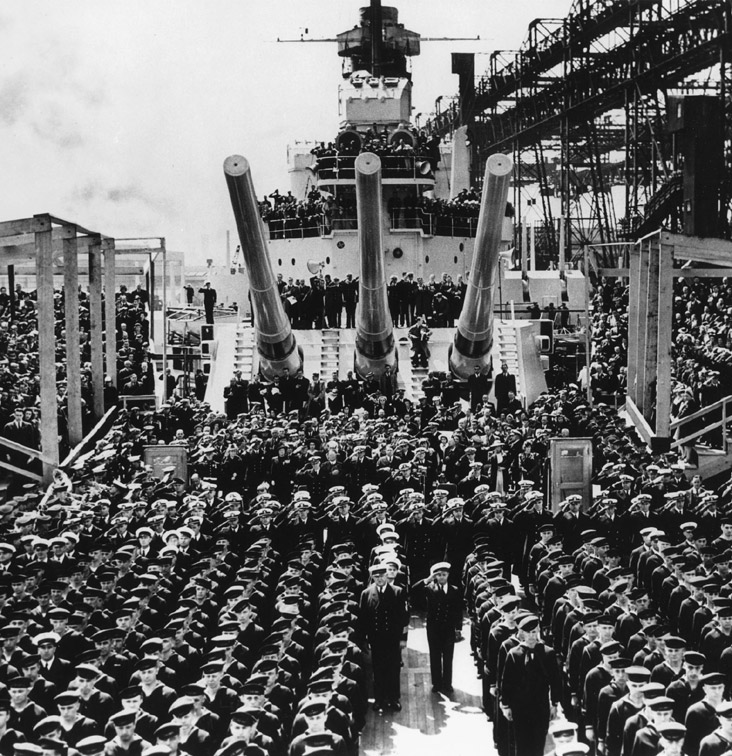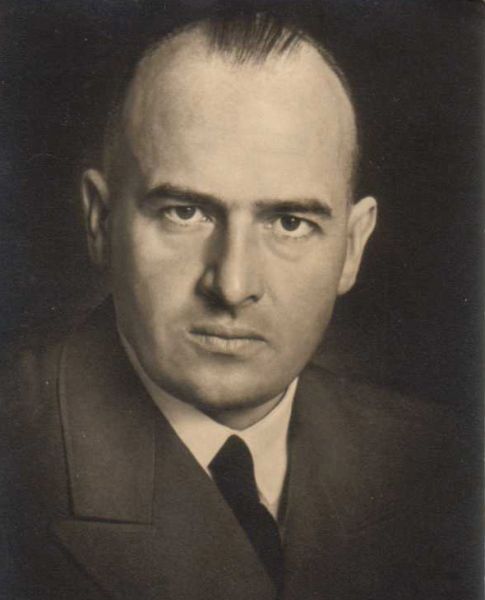They Don't Want to Fight, But by Jingo!
The War Illustrated, Volume 4, No. 91, Page 545, May 30, 1941.
 The new American battleship, North Carolina, being placed in commission at the New York Navy Yard. She is one of the Washington class of six ships of 35,000 tons displacement (about 41,000 tons full load). Behind the serried ranks of her crew are three of her nine 16-inch guns. This ship, the largest and most formidable ever built in the United States, will take her place in the fleet's battle line at midsummer. The Washington herself was commissioned at Philadelphia Navy Yard on May 15, and a sister ship, the South Dakota, is expected to be ready early next year. Photo, Wide World.
The new American battleship, North Carolina, being placed in commission at the New York Navy Yard. She is one of the Washington class of six ships of 35,000 tons displacement (about 41,000 tons full load). Behind the serried ranks of her crew are three of her nine 16-inch guns. This ship, the largest and most formidable ever built in the United States, will take her place in the fleet's battle line at midsummer. The Washington herself was commissioned at Philadelphia Navy Yard on May 15, and a sister ship, the South Dakota, is expected to be ready early next year. Photo, Wide World.
Today the American Navy has in all about 800 ships. With the new battleship North Carolina it has 16 battleships [17 with the Washington], 12 in battle line; it has 6 aircraft carriers; 18 heavy cruisers, 19 light; 159 destroyers, half of which have been built in the past nine years; 40-odd old last-war destroyers, and 105 submarines. The test of the Navy's quality is in its cruisers and destroyers. It is generally admitted that the light – that is, the 6-inch-gun cruisers – are the best of their type in existence; they fire a hundred 6-inch shells every minute. The new destroyers, says one neutral naval expert who recently looked over them, "are the best destroyers I've seen, and they are also A.A. ships".
This Navy operates from bases on the east coast, going from north to south, at now Greenland, and then Boston, New York, Philadelphia, Hampton Roads and Florida; on the west coast, from Puget Sound to San Francisco, San Pedro and San Diego, and far our in the mid-Pacific to Pearl Harbor, which is being equipped to handle a whole fleet. Since the historic agreement with Great Britain last autumn it now has supplementary bases in the East, all the way from Newfoundland to Bermuda, to the Bahamas, to Trinidad and British Guiana.
When the United States woke up with a jump after the fall of France there were two main problems facing the Navy Department. One was to modernize the fighting craft; the other to strengthen the Fleet Auxiliary. During this last year the Navy has not merely managed to do what it wanted; it is ahead of time. Since Colonel Frank Knox became Secretary of the Navy, the Government has bought up every available tug, oiler, cargo boat and ammunition ship, and has now 2,600 merchant vessels on hand. It is rushing the construction of every type of auxiliary from corvettes to long-range patrol planes.
Alistair Cooke's American Commentary, May 10, 1941.
Index
Previous article
I Was There! - They Call Us 'Ancient and Tattered Airmen'
Some of the Air Transport Auxiliary pilots who ferry aircraft from factories to R.A.F. stations are women – it was on this service that Amy Johnson lost her life – and here one of them describes h
Next article
I Was There! - I Captured a Nazi Parachutist - It Was Hess!
When Rudolf Hess, Hitler's Deputy, landed by parachute near Glasgow on the night of May 10th he was first encountered at Newton Mearns, 8 miles from Glasgow, by a Scottish ploughman, David McLean, who




